What are solar batteries? These energy storage solutions are crucial to making solar power systems more efficient. Keep on reading if you want to know more about them.
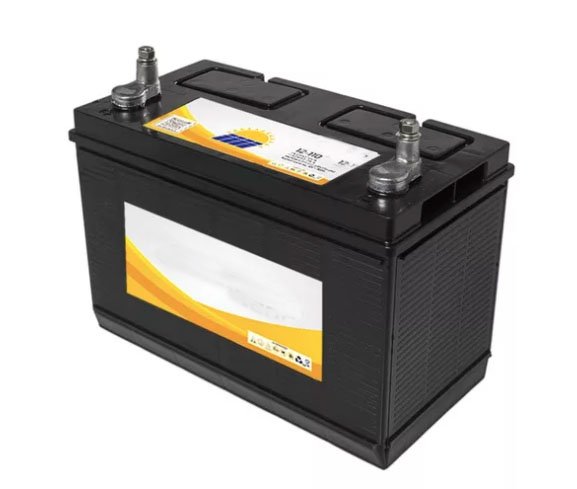
What are solar batteries?
Solar batteries, also known as solar energy storage systems or solar battery storage, are devices that store the excess electricity generated by solar panels during periods of sunlight. These batteries play a crucial role in maximizing the efficiency and effectiveness of solar power systems. Here’s a brief overview:
- Energy Storage: Solar batteries store the surplus electricity generated by solar panels when the sun is shining, but demand for electricity is low. Instead of letting this excess energy go unused, it is stored in the battery for later use.
- Off-Grid Systems: Solar batteries are essential components for off-grid solar power systems. Where there is no access to the electrical grid, solar panels generate electricity during the day. So, the stored energy in batteries is used at night or when the sun is not shining.
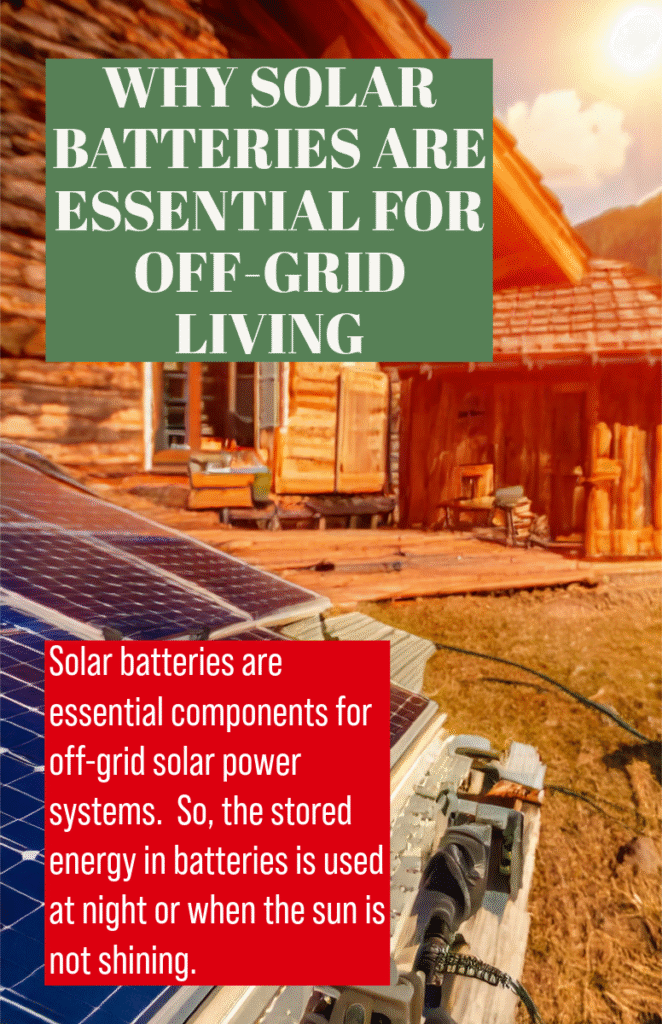
- Grid-Tied Systems with Energy Independence: In grid-tied solar power systems, excess energy can be stored in solar batteries rather than being fed back into the grid. You can use this energy when the solar panels are not producing electricity, such as during cloudy days or at night. Solar batteries provide a reliable source of backup power during grid outages. When the electricity is off, solar batteries can supply it to essential appliances and devices, enhancing energy resilience for homeowners and businesses.
- Time-of-Use Optimization: In regions with time-of-use electricity pricing, solar batteries can help optimize energy consumption by storing electricity when rates are low and discharging it during peak-rate periods, leading to potential cost savings.
- Reducing Reliance on Fossil Fuels: Solar batteries contribute to reducing dependence on fossil fuels by enabling the efficient use of clean, renewable solar energy. This helps decrease greenhouse gas emissions and promotes sustainability.
Solar batteries enhance the overall efficiency and reliability of solar power systems, making them a key component in the transition to more sustainable and resilient energy solutions.
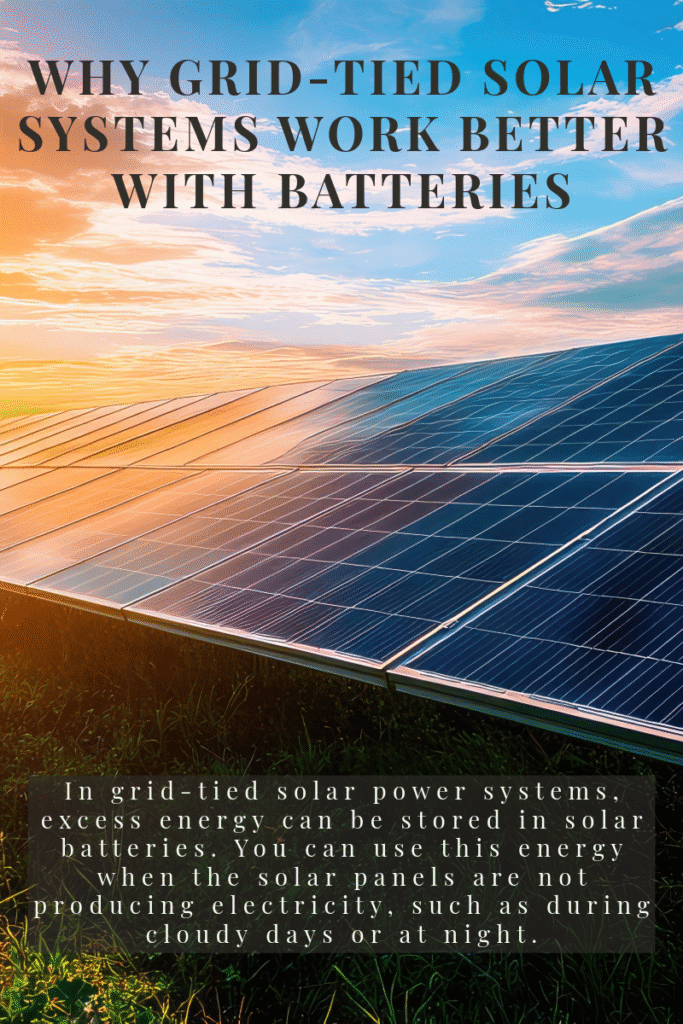
How do solar batteries work?
Here’s a step-by-step explanation of how solar batteries work:
- Solar Panel Electricity Generation: Solar panels convert sunlight into direct current (DC) electricity through the photovoltaic effect. Each solar panel consists of multiple solar cells, typically made of silicon, that generate an electric current when exposed to sunlight.
- Charge Controller: The DC electricity generated by solar panels is sent to a charge controller, which regulates the voltage and current to prevent overcharging and damage to the battery. The charge controller ensures that the solar battery receives a controlled and optimal flow of electricity.
- Battery Storage: Then, the solar battery stores the regulated DC electricity. The battery stores this excess energy for later use when the electricity demand exceeds the current solar generation, such as at night or on cloudy days. Solar batteries are commonly rechargeable and use various technologies like lithium-ion, lead-acid, or flow batteries.
- Inverter Conversion: When electricity is needed, the stored DC energy in the solar battery is converted to alternating current (AC) using an inverter. AC is the standard form of electricity used for appliances and devices in most homes and businesses.
- Powering Electrical Loads: The inverter sends the converted AC electricity to the electrical panel of the building, where it can be distributed to power lights, appliances, and other electrical loads.
- Grid Interaction (if applicable): In grid-tied solar power systems, excess electricity generated by solar panels that is not immediately needed can be fed back into the grid. Conversely, when solar panels are not generating enough electricity, electricity can be drawn from the grid or the solar battery.
- Monitoring and Control: Sophisticated solar power systems often include monitoring and control systems to optimize energy usage. You can program these systems to prioritize the use of solar-generated electricity over grid power.
The entire process is designed to improve solar power systems, provide backup power during grid outages, and enhance overall energy efficiency. The technology involved in solar batteries, including charge controllers and inverters, ensures that the energy flows efficiently and safely between the solar panels, the battery, and the electrical loads.
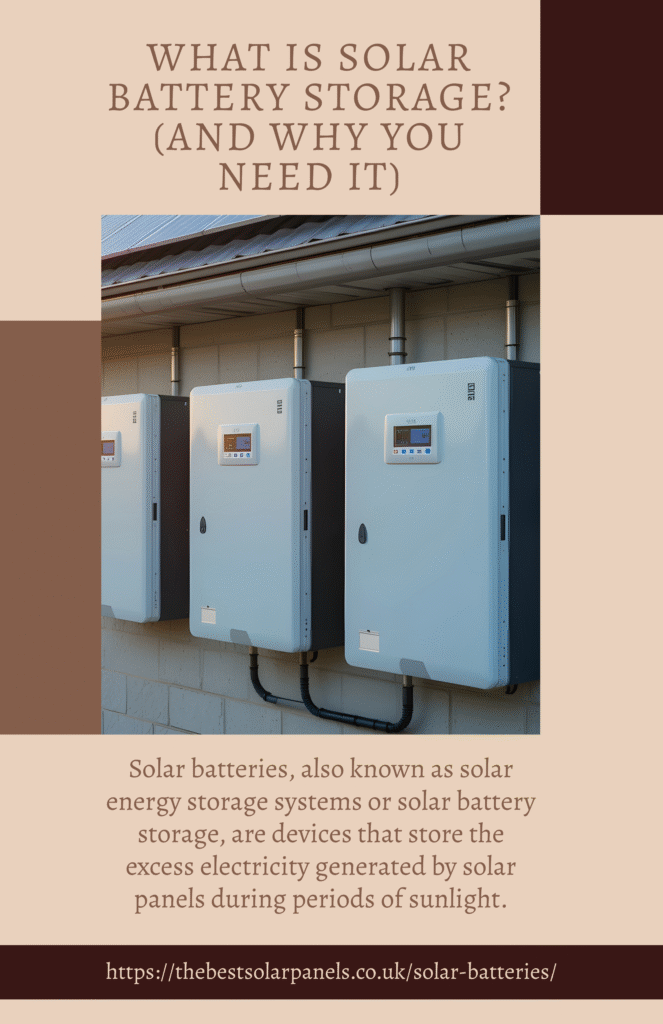
Types of solar batteries
The choice of a specific type depends on factors such as cost, energy storage capacity, cycle life, and the requirements of the solar power system. Here are some common types of solar batteries:
| Type of Battery | Advantages | Applications |
| Lithium-Ion Batteries | High energy density, longer cycle life, lightweight, and compact. | Residential and commercial solar energy storage, and electric vehicles. |
| Lead-Acid Batteries | Relatively low cost, mature technology, suitable for deep-cycle applications. | Off-grid solar systems, home backup power and telecommunication systems. |
| Flow Batteries | Long cycle life, high efficiency, scalable energy storage capacity. | Grid-scale energy storage, large-scale solar power systems. |
| Nickel-Cadmium (Ni-Cd) Batteries | Grid-scale energy storage, and large-scale solar power systems. | Remote solar power systems, backup power for critical infrastructure. |
| Saltwater Batteries (Sodium-Ion) | Non-toxic and environmentally friendly, long cycle life. | Residential solar energy storage. |
| Lead-Carbon Batteries | Improved cycle life compared to traditional lead-acid batteries. | Solar power systems with high cycling requirements. |
| Lithium Iron Phosphate (LiFePO4) Batteries | Enhanced safety, and longer cycle life compared to other lithium-ion batteries. | Residential solar storage, and electric vehicles. |
| Supercapacitors | Very high power density, fast charging and discharging. | Short-term energy storage, smoothing power fluctuations in solar systems. |
| Hybrid Batteries (Combining Different Chemistries) | Can combine the strengths of different battery types for optimized performance. | Customized solutions for specific energy storage needs. |
The choice of a specific type of solar battery depends on the requirements of the solar power system, budget considerations, and the intended application.
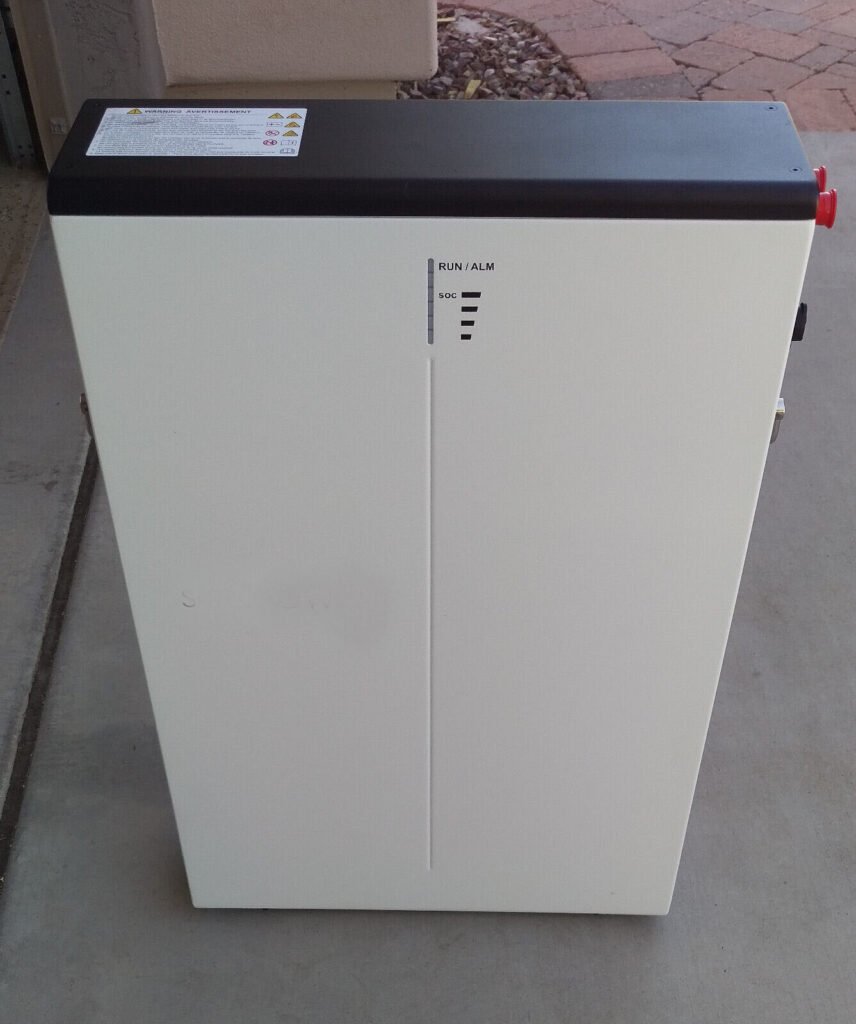
Pros and cons of solar batteries
Pros
Cons
Advantages explained
- Energy Storage: Solar batteries store excess electricity generated during sunny periods, allowing for use when solar panels are not producing electricity, such as at night or during cloudy days.
- Energy Independence: Solar batteries provide a degree of energy independence, enabling users to rely less on the electrical grid and conventional energy sources.
- Backup Power: Solar batteries offer a reliable source of backup power during grid outages, ensuring continuous electricity supply for essential appliances and devices.
- Grid Optimization: In grid-tied systems, solar batteries allow users to optimize energy usage by storing electricity when rates are low. And also, they discharge it during peak-rate periods, potentially leading to cost savings.
- Increased Self-Consumption: Solar batteries enable higher self-consumption of solar-generated electricity, reducing the need to return excess energy to the grid.
- Environmental Benefits: Solar batteries contribute to the reduction of greenhouse gas emissions by promoting using clean, renewable energy.
Disadvantages explained
- Initial Cost: The upfront cost of purchasing and installing solar batteries can be relatively high, although prices have been decreasing with advancements in technology and increased market competition.
- Limited Energy Storage: The storage capacity of solar batteries is finite, and users need to carefully size their systems to meet their energy storage requirements. This limitation can be a challenge during extended periods of low sunlight.
- Maintenance: Some types of solar batteries require regular maintenance, such as electrolyte checks for lead-acid batteries. However, newer technologies like lithium-ion batteries typically have lower maintenance requirements.
- Environmental Impact: The manufacturing and disposal of certain types of batteries, especially those containing toxic materials, can have environmental implications. However, efforts are underway to develop more sustainable battery technologies.
- Limited Lifespan: All batteries have a limited number of charge-discharge cycles before their performance degrades. Users may need to replace batteries after a certain number of years. This depends on the battery chemistry and usage patterns.
- Technology Evolution: Rapid advancements in battery technology mean that newer and more efficient models may become available shortly after buying a solar battery system, potentially leading to obsolescence concerns.
How to choose a solar battery?
Here are key factors to consider when choosing a solar battery:
- Energy Storage Capacity:
Determine your energy storage requirements based on your daily electricity consumption and the desired level of energy independence during periods of low sunlight.
- Battery Chemistry:
Different battery chemistries (e.g., lithium-ion, lead-acid, flow batteries) have varying characteristics, including energy density, cycle life, and maintenance requirements. Choose a chemistry that aligns with your preferences and priorities.
- Cycle Life:
Consider the number of charge-discharge cycles the battery can undergo over its lifespan. A longer cycle life generally translates to a more durable and cost-effective solution.
- Depth of Discharge (DoD):
Determine the depth to which the battery can be discharged without negatively impacting its performance. A higher depth of discharge allows for more usable capacity but may affect the battery’s longevity.
- Round-Trip Efficiency:
Assess the round-trip efficiency. This represents how much energy is retained during the charging and discharging process. Higher efficiency means less energy loss and better overall system performance.
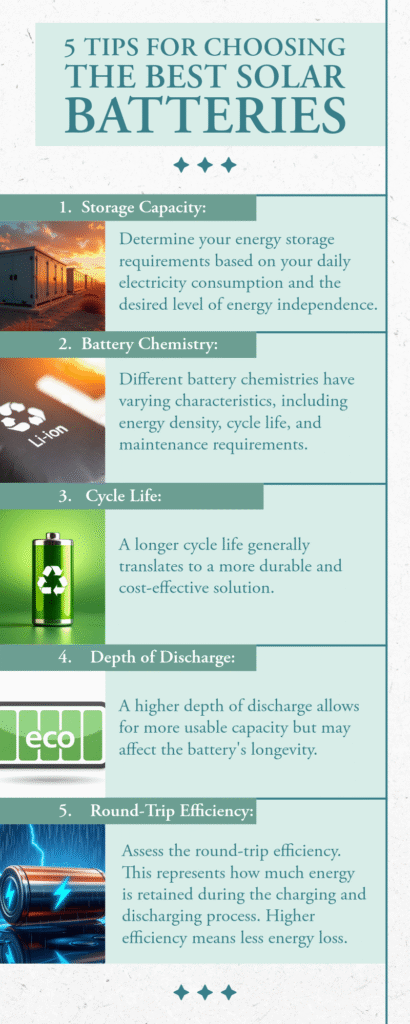
- Physical Size and Weight:
Consider the available space and installation requirements for the solar battery. Different battery types have varying sizes and weights, and some may be more suitable for specific locations or applications.
- Installation and Compatibility:
Ensure the selected solar battery is compatible with your existing solar power system. Consider installation requirements, including wiring and mounting considerations.
- Manufacturer Reputation and Warranty:
Choose batteries from reputable manufacturers with a track record of quality and reliability. Check the warranty terms, including the duration and coverage, to ensure long-term protection for your investment.
- Cost:
Compare the initial cost and overall cost of ownership, considering maintenance requirements, cycle life, and efficiency. Evaluate the long-term financial benefits of the chosen battery.
- Scalability:
If you plan to expand your solar power system in the future, consider the scalability of the chosen battery technology. Some systems allow for easy integration of additional batteries to meet growing energy storage needs.
- Environmental Impact:
Assess the environmental impact of the battery’s manufacturing, use, and disposal. Consider opting for batteries with lower environmental footprints or those made from more sustainable materials.
- User-Friendly Monitoring:
Choose a solar battery with user-friendly monitoring and control features. Access to real-time data on energy production, storage levels, and system performance can enhance user experience and optimization.
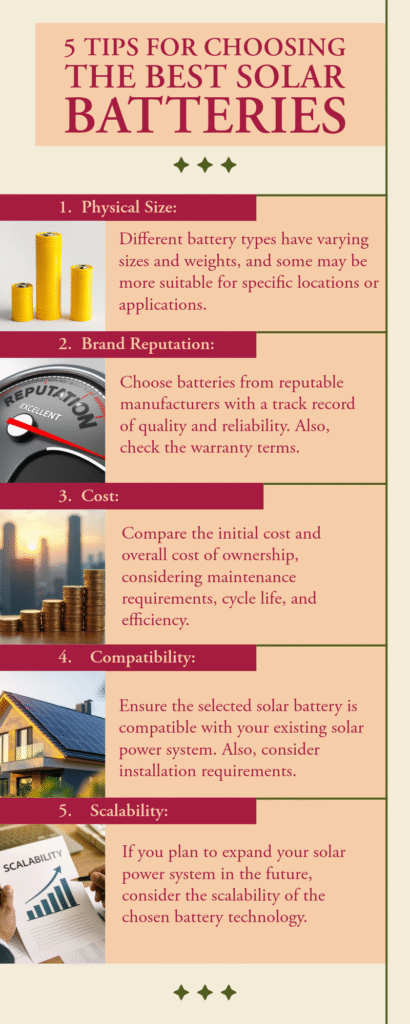
What size solar battery do you need to power a house?
Here are the general steps to estimate the size of a solar battery for a house:
Determine Daily Electricity Consumption:
Understand your household’s average daily electricity consumption, typically measured in kilowatt-hours (kWh). Review your utility bills or use energy monitoring devices to gather this data.
Calculate Solar Panel Generation:
Assess the energy production capacity of your solar panels. This involves considering factors such as the panel capacity (in watts), the number of sunlight hours in your location, and any shading or orientation issues that may affect panel efficiency.
Estimate Required Storage Capacity:
Determine how many hours of backup power you need during periods of low sunlight or grid outages. Multiply your average daily consumption by the number of backup hours to estimate the required storage capacity in kilowatt-hours (kWh).
Consider Battery Depth of Discharge (DoD):
Factor in the depth of discharge (DoD) of the battery. For example, if you choose a battery with a 70% DoD, you may need to oversize the battery capacity to ensure you meet your daily energy requirements.
Evaluate Round-Trip Efficiency:
Account for the round-trip efficiency of the battery, which represents how much energy is retained during the charging and discharging process. For instance, if a battery has an efficiency of 90%, you may need to adjust the required storage capacity accordingly.
Consult with Solar Professionals:
Engage with solar professionals or energy consultants to assess your specific requirements. They can provide insights into local solar conditions, recommend suitable battery technologies, and ensure that your system is appropriately sized.
Consider Future Expansion:
If you plan to expand your solar power system in the future, consider the scalability of the chosen battery technology. Some systems allow for the addition of more batteries to meet growing energy storage needs.
It’s important to note that battery size alone does not determine the feasibility of powering a house with solar energy. You should design and configure the overall solar power system properly, including solar panels, inverters, and other components.
How long do solar batteries last?
The lifespan of solar batteries can vary based on several factors, including the type of battery, usage patterns, maintenance practices, and environmental conditions. Here are general estimates for the lifespan of common types of solar batteries:
Lead-Acid Batteries:
- Flooded Lead-Acid (FLA) Batteries: 5 to 15 years
- Sealed Lead-Acid (SLA) Batteries: 5 to 10 years
Lithium-Ion Batteries:
- Lithium Iron Phosphate (LiFePO4) Batteries: 10 to 20 years
- Other Lithium-Ion Chemistries: 5 to 15 years
Flow Batteries:
- 10 to 20 years or more
These estimates are general guidelines, and the actual lifespan can vary. Several factors can influence the longevity of solar batteries:
- Depth of Discharge (DoD): Batteries that are regularly discharged to a higher percentage of their capacity (higher DoD) may have a shorter lifespan than those discharged to a lower percentage.
- Temperature: Extreme temperatures, both high and low, can impact battery performance and reduce lifespan. It’s important to consider the temperature conditions at the installation site.
- Maintenance: Regular maintenance practices, such as checking electrolyte levels (for lead-acid batteries) or following manufacturer-recommended guidelines, can contribute to extending the lifespan of batteries.
- Usage Patterns: How frequently and under what conditions the batteries are cycled (charged and discharged) can impact their longevity. Batteries used in off-grid systems or for frequent cycling may have a shorter lifespan.
- Battery Management Systems (BMS): Advanced battery management systems, common in lithium-ion batteries, can help optimize charging and discharging processes, contributing to longer life.
- Technology Advances: Ongoing advancements in battery technology may lead to longer-lasting batteries as newer technologies are developed and deployed.
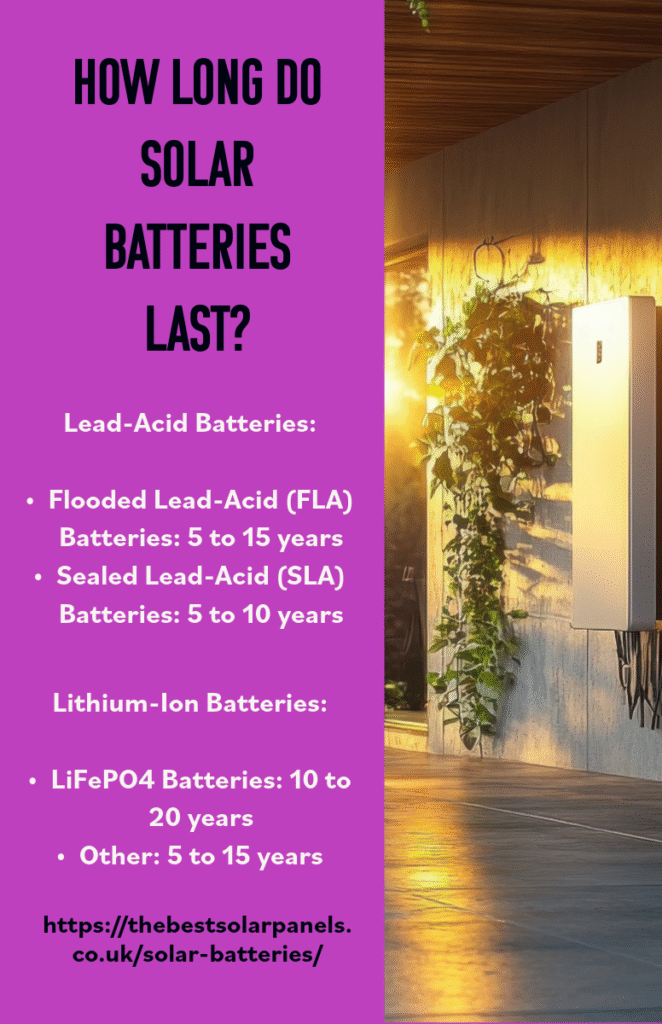
What is the cost of batteries for solar panels?
Several factors influence the cost of solar batteries, such as the type of battery, its capacity, cost of installation and brand.
- 5 kwh: From 1200 to 4750 pounds
- 10 kwh: From 2500 to 6750 pounds
- 15 kwh: From 4700 to 8300 pounds.
Can you install a battery without solar panels?
Yes, it is possible to install a battery storage system without solar panels. You can install batteries as standalone energy storage solutions. And they can serve various purposes, including backup power, load shifting, and energy resilience. Here are some scenarios where installing a battery without solar panels might be applicable:
- Backup Power: You can install a battery system as a backup power source for your home or business. In case of a grid outage, the battery can provide stored energy to critical appliances and devices, ensuring continued operation.
- Time-of-Use Optimization: In regions with time-of-use electricity pricing, a battery can be charged during periods of low electricity rates and discharged during peak-rate periods. This can help reduce electricity costs by avoiding high-rate charges during peak hours.
- Load Shifting: You can use battery systems to shift energy consumption from peak to off-peak times. This is particularly useful in areas with dynamic pricing or demand charges, where avoiding high electricity costs during peak demand can result in financial savings.
- Off-Grid Applications: You can use batteries for off-grid applications where a reliable source of electricity is needed, but connecting to the grid is not feasible or cost-effective. This is common in remote locations or for specific purposes like powering a cabin or a communication tower.
- Grid Support Services: In some regions, utility companies may offer programs that incentivize customers to install batteries to provide grid support services, such as frequency regulation or demand response. These programs aim to enhance grid stability and reliability. When installing a battery without solar panels, it’s essential to consider factors such as the desired capacity, intended use, and compatibility with the local electrical grid. Also, you should configure the battery system properly and install it by qualified professionals to ensure safety and compliance with local regulations
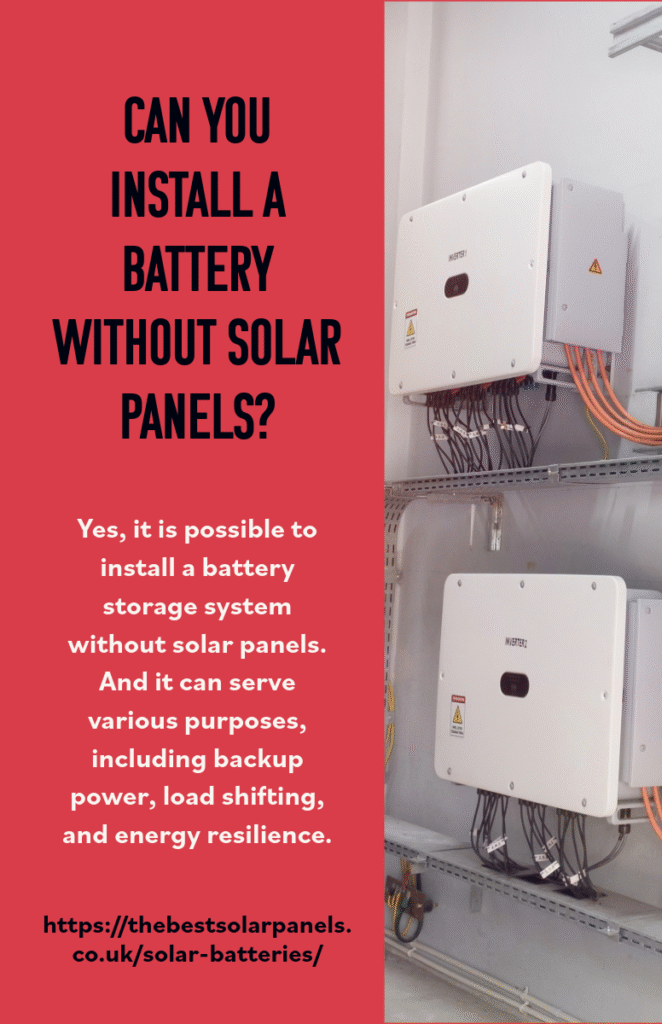



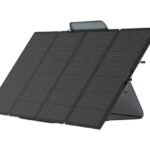
Leave a Reply